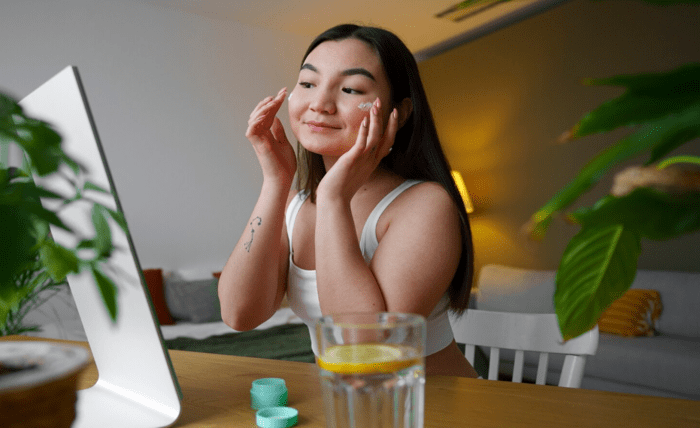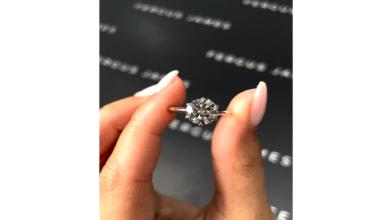
Introduction:
In the era of digital living, blue light has emerged as one of the most talked-about topics in skincare. Once associated only with sunlight, it’s now linked to screens, from smartphones and tablets to computers and LED lighting. As people spend more time indoors and in front of devices, concerns have grown that blue light might contribute to premature skin aging, pigmentation, and inflammation.
Blue Light and Its Sources:
“Blue light, also known as high-energy visible (HEV) light, sits within the visible spectrum of light, between ultraviolet (UV) and infrared rays. It’s characterized by its shorter wavelength and higher energy, typically ranging from 400 to 500 nanometers. While most people associate blue light with digital screens, it’s important to note that the primary source of blue light exposure is the sun itself. In fact, sunlight emits about 100 to 1,000 times more blue light than electronic devices. However, since people now spend hours daily staring at screens just inches from their faces, scientists and consumers have begun to question whether this cumulative exposure might still impact skin health over time”. Says Sean Elias, Founder, Moesgroup
The Science Behind Blue Light and Skin Damage:
“Over the past decade, several laboratory studies have investigated how blue light interacts with skin cells. The findings suggest that blue light can trigger oxidative stress, leading to the production of reactive oxygen species (ROS). These unstable molecules can damage cellular components like proteins, lipids, and DNA, similar to what happens with UV exposure. Oxidative stress is one of the key mechanisms behind skin aging, contributing to wrinkles, fine lines, and loss of firmness. Additionally, blue light has been shown to influence melanocytes, the pigment-producing cells in the skin. In darker skin tones, this can lead to post-inflammatory hyperpigmentation, where patches of skin darken after inflammation or acne”. Says Shamsa Kanwal, M.D, Consultant Dermatologist, myhsteam
The Role of Blue Light in Pigmentation and Aging:
“One of the most compelling findings about blue light relates to pigmentation changes. Research has shown that prolonged exposure can increase melanin production, leading to dark spots or uneven skin tone. This appears to be more pronounced in individuals with medium to dark complexions, where melanocytes respond more actively to oxidative stress. Still, dermatologists caution that these effects are minimal compared to those caused by UVA and UVB rays. In fact, sitting next to a sunny window without sunscreen for an hour exposes the skin to far more blue light than an entire day spent in front of digital screens. This is why traditional sun protection remains far more critical than any blue light defense routine”. Says Clinify Health, cofounder & CEO, CombineHealth AI
Do Blue Light Protection Products Really Work:
“As awareness of blue light has grown, so too has the number of skincare products claiming to defend against it. Serums, moisturizers, and sunscreens now frequently advertise “digital light defense” or “HEV protection.” But the question remains: do these products genuinely offer a benefit? Most blue light protection formulations rely on antioxidants, iron oxides, and botanical extracts. Antioxidants like vitamin C, niacinamide, and green tea extract help neutralize reactive oxygen species before they can damage cells. Iron oxides, on the other hand, provide physical protection by reflecting visible light, making them particularly useful in tinted sunscreens or foundations”. Says Rune Bech, co-founder, NetDoctor
The Digital Lifestyle Factor:
“Even if screen-emitted blue light poses a relatively minor direct risk to skin health, the digital lifestyle associated with prolonged screen time can have indirect consequences. Long hours at a desk often lead to poor posture, dehydration, and fatigue, all of which can affect the skin’s appearance. Extended screen use also disrupts circadian rhythms, especially when devices are used late into the night. Blue light exposure from screens can suppress melatonin production, leading to sleep disturbances. Poor sleep is a well-known contributor to dullness, puffiness, and increased cortisol levels, all of which accelerate visible aging and inflammation”. Says Brigham Hyde, CEO, Atropos Health
Real Protection Strategies That Work:
“While blue light–specific protection may be of limited necessity, comprehensive skincare strategies can still make a difference in defending the skin from environmental aggressors. The first and most effective line of defense is daily sunscreen use. A broad-spectrum SPF protects against both UVA and UVB radiation, and tinted formulations containing iron oxides offer some degree of visible light protection as well. For those spending significant time outdoors or near windows, this is far more impactful than worrying about screen exposure. Next, antioxidants play a vital role. Topical products containing vitamins C and E, ferulic acid, or green tea polyphenols help neutralize free radicals before they can damage skin structures. These ingredients also improve overall skin brightness and texture, offering benefits beyond blue light protection”. Says Chris McGhee, CEO, Current Health
The Role of Education and Evidence in Skincare Choices:
“The skincare industry thrives on innovation, but it also risks overwhelming consumers with marketing language that blends science and speculation. Blue light protection serves as a prime example of how partial truths can fuel an entire product trend. The responsibility now lies with both brands and professionals to communicate evidence-based information. Dermatologists emphasize that not all light exposure is harmful, and in some contexts, visible light is even beneficial for mood regulation and skin treatments. The challenge is to educate consumers without inducing unnecessary fear”. Says Anish Bafna, CEO, Healthium Medtech
A Blend of Science and Skepticism:
So, is blue light skincare protection fact or fiction? The answer lies somewhere in between. The science supporting blue light’s potential to harm skin exists, but it’s context-dependent and far less alarming than marketing narratives suggest. The intensity and duration of screen-related exposure are generally too low to cause significant skin damage. That said, visible light, including blue light from the sun, does play a role in oxidative stress and pigmentation, particularly for those who spend long hours in natural light or near windows. In these cases, tinted sunscreens and antioxidant-rich products offer genuine value.
Conclusion:
While blue light protection has captured public attention, the truth lies in moderation and science. Current evidence suggests that screen exposure alone poses minimal risk, while sunlight remains the dominant source of blue light. Instead of chasing trends, focusing on proven practices, broad-spectrum sunscreen, antioxidants, balanced nutrition, and mindful screen habits offers the most effective defense. True skin health isn’t about fear of technology but about understanding, prevention, and consistency in daily care.




